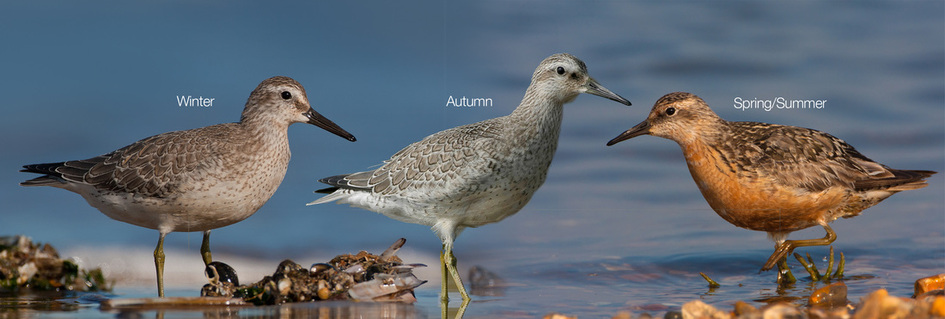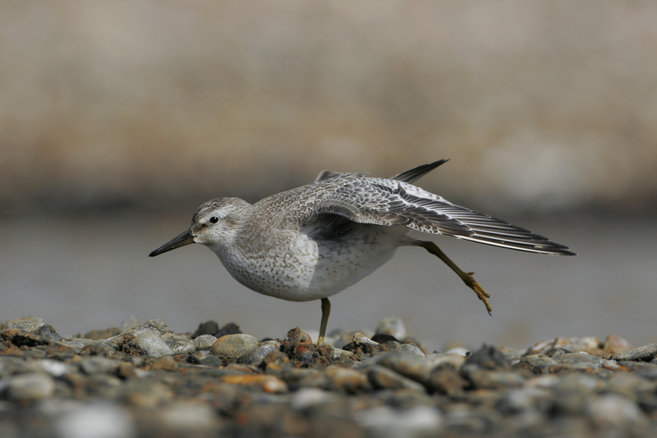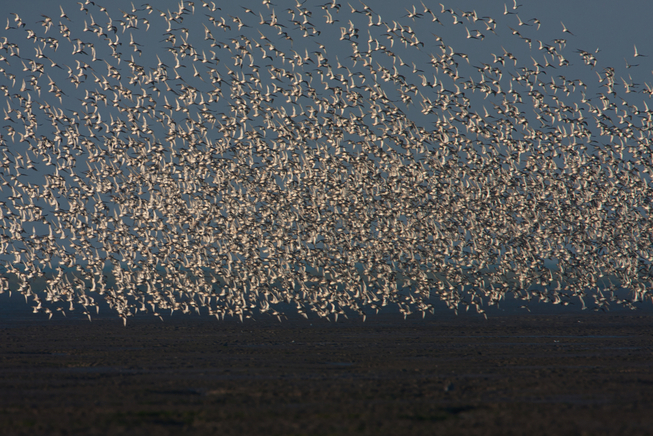Knot plumage changes
|
The Red Knot (Calidris canutus) (just Knot in Europe), is a medium sized shorebird which breeds in tundra and the Arctic Cordillera in the far north of Canada, Europe, and Russia. It is a large member of the Calidris sandpipers, second only to the Great Knot.
Their diet varies according to season; arthropods and larvae are the preferred food items at the breeding grounds, while various hard-shelled molluscs are consumed at other feeding sites at other times. North American breedersmigrate to coastal areas in Europe and South America, while the Eurasian populations winter in Africa, Papua New Guinea, Australia and New Zealand. This species forms enormous flocks when not breeding. An adult Red Knot is the second largest Calidris sandpiper, measuring 23–26 cm (9–10 in) long with a 47–53 cm (18.5–21 in) wingspan. The body shape is typical for the genus, with a small head and eyes, a short neck and a slightly tapering bill that is no longer than its head. It has short dark legs and a medium thin dark bill. The winter, or basic, plumage becomes uniformly pale grey, and is similar between the sexes. The alternate, or breeding, plumage is mottled grey on top with a cinnamon face, throat and breast and light-coloured rear belly. The alternate plumage of females is similar to that of the male except it is slightly lighter and the eye-line is less distinct. canutus, islandica and piersmai are the "darker" subspecies. Subspecies rogersi has a lighter belly than either roselaari orpiersmai, and rufa is the lightest in overall plumage. The transition from alternate to basic plumages begins at the breeding site but is most pronounced during the southwards migration. The molt to alternate plumage begins just prior to the northwards migration to the breeding grounds, but is mostly during the migration period.
The large size, white wing bar and grey rump and tail make it easy to identify in flight. When feeding the short dark green legs give it a characteristic 'low-slung' appearance. When foraging singly, they rarely call, but when flying in a flock they make a low monosyllabic knutt and when migrating they utter a disyllabic knuup-knuup. They breed in the moist tundra during June to August. The display song of the male is a fluty poor-me. The display includes circling high with quivering wing beats and tumbling to the ground with the wings held upward. Both sexes incubate the eggs, but the female leaves parental care to the male once the eggs have hatched. Juvenile birds have distinctive submarginal lines and brown coverts during the first year. In the breeding season the males can be separated with difficulty (<80% accuracy in comparison to molecular methods based on the more even shade of the red underparts that extend towards the rear of the belly.
The weight varies with subspecies, but ranges between 100 and 200 g (45–91 oz). Red Knots can double their weight prior to migration. Like many migratory birds they also reduce the size of their digestive organs prior to migration. The extent of the atrophy is not as pronounced as species like the Bar-tailed Godwit, probably because there are more opportunities to feed during migration for the Red Knot. Red Knots are also able to change the size of their digestive organs seasonally. The size of the gizzard increases in thickness when feeding on harder foods on the wintering ground and decreases in size while feeding on softer foods in the breeding grounds. These changes can be very rapid, occurring in as little as six days. |
Interesting Facts
More ID HelpBarn Owl
Bar tailed Godwit Bearded Reedling Black tailed Godwit Common Kestrel Great Spotted Woodpecker Kingfisher Knot Dunlin Reed Bunting Ringed Plover Marsh Harrier Northern Wheatear Sanderling Siskin Some British Birds of Prey Stonechat Wader ID Help Winter Thrushes Useful Links The Barn Owl Trust The Hawk and Owl Trust RSPB Underwater Photography Wildlife & Environmental Causes Scottish Wildlife National Geographic |
All images appearing on this website and its content are the copyright of John S Betts. All rights reserved.



